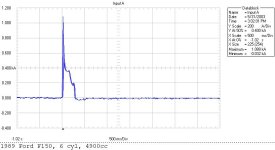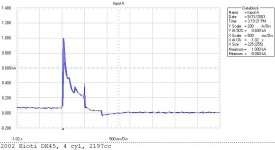Charlie_in_TX
Gold Member
- Joined
- Aug 27, 2002
- Messages
- 475
Where is the torque measured? Torque produces by the starter or on the crankshaft?
Lets apply a little math and see relitive pressure per square inch. A JD 4210 (28hp) has a displacement of 81 cu in. Thats 27 cu in per cylinder. Bore and stroke are not speced. If the bore is 3in the stroke will be 3.85in. Sounds about right for a low RPM hi torue motor. A 3in bore has a 7in surface area. At 400 psi compression that is 2800 lbs of force.
I will really guess on the 3.7l jeep. 3.7l is about 225 cu in or 37.6 cu in per cylinder. If the bore is 3.84in the stroke is 3.25in. Sounds about right for a high RPM motor. 3.84in bore has a 11.5 in surface area. At 175 psi compression that is 2025 lbs of force.
Now assuming the both have the same flywheel and starter the deisel will require more force(torque) for each compression stroke. However, the gas will require more work to be performed by the starter for each revolution of the crankshaft.
So in answer to your question.... it depends. Are we talking peak torque or average torque? Peak torque = 30hp deisel. Highest average = 3.7l gas.
Lets apply a little math and see relitive pressure per square inch. A JD 4210 (28hp) has a displacement of 81 cu in. Thats 27 cu in per cylinder. Bore and stroke are not speced. If the bore is 3in the stroke will be 3.85in. Sounds about right for a low RPM hi torue motor. A 3in bore has a 7in surface area. At 400 psi compression that is 2800 lbs of force.
I will really guess on the 3.7l jeep. 3.7l is about 225 cu in or 37.6 cu in per cylinder. If the bore is 3.84in the stroke is 3.25in. Sounds about right for a high RPM motor. 3.84in bore has a 11.5 in surface area. At 175 psi compression that is 2025 lbs of force.
Now assuming the both have the same flywheel and starter the deisel will require more force(torque) for each compression stroke. However, the gas will require more work to be performed by the starter for each revolution of the crankshaft.
So in answer to your question.... it depends. Are we talking peak torque or average torque? Peak torque = 30hp deisel. Highest average = 3.7l gas.

